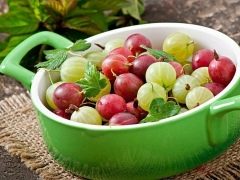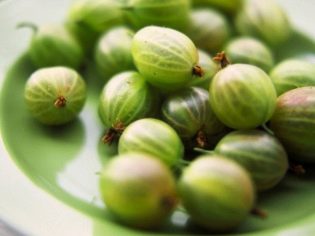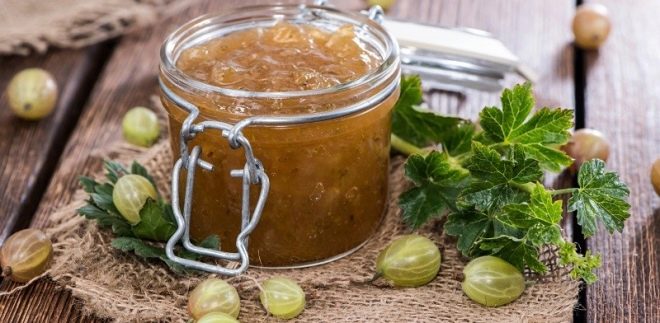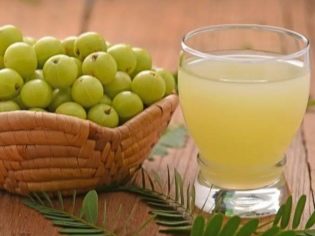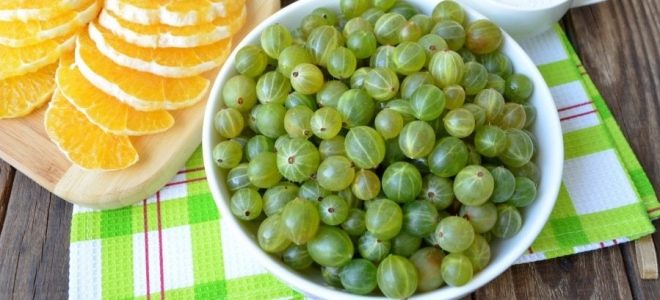Gooseberry in breastfeeding and baby feeding
Gooseberry is a healthy and tasty berry with an amazing taste that does not look like anything. Both adults and children love her. In addition to taste, gooseberry is very good for health. It is not surprising that nursing women are interested in the possibility of eating gooseberries, and parents of infants often ask the question when you can put gooseberries in the baby’s diet.
In this article we will talk about the features of the use of berries during breastfeeding and in childhood.
About the product
Gooseberry is a frequent inhabitant of summer and garden plots in Russia. It does not require painstaking care, and therefore it is convenient to grow it, each year receiving rich yields of tasty and nutritious fruits. In the berries of this culture contains a large amount of magnesium, necessary for the nervous system. It is especially valuable that magnesium is advantageously supplemented with a high content of B vitamins, which are also necessary for the health of the brain and blood vessels. From a portion of gooseberry you can get quite a large amount of vitamins E and C, as well as iron, potassium and copper, phosphorus and selenium. In the dark gooseberry varieties there is a lot of vitamin PP, which promotes the removal of toxins from the body.
Gooseberry is an excellent assistant in the treatment of vascular diseases. It enhances mood, regulating the activity of the nervous system, has an unproven, but popular antitumor effect, softens the work of the stomach and intestines, normalizing digestive processes. Striped fruits have a moderate anti-inflammatory effect, saturate the blood with hemoglobin, and also prevents the development of constipation.
Eat it in its pure form, while not needing to remove the skin - it concentrates the most useful substances. Berries are used to make jam, jam, make compotes and make fruit drinks, add berries to salads and other dishes. The fruits of the culture are not recommended for exacerbation of peptic ulcer, colitis, diarrhea. It is also not recommended to eat gooseberries for people with diabetes. Berry has no other contraindications - allergy to it develops quite rarely, the product is considered to be hypoallergenic.
Nursing moms
Mothers during lactation from the gooseberry there is an additional benefit - it is low-calorie, and therefore allows you to accelerate weight loss after childbirth, without having a negative effect on lactation. Gooseberry, introduced into the diet of a nursing mother, will help to avoid unpleasant manifestations of postpartum constipation - a phenomenon not that, alas, rare.
The immunity of a woman is greatly undermined by pregnancy and childbirth, and here the gooseberry with its immunostimulating properties will be very useful. A serotonin in the composition of the berries will help to cope with postpartum instability of mood and will not allow the development of depression.
In short, gooseberry feeding is not only possible but necessary. What matters is the choice of variety. In the first month of the baby’s life, mothers should better avoid red and yellow gooseberries, but varieties that produce green berries are not prohibited to be eaten.
The permission does not mean that immediately after discharge from the maternity hospital, the young mother can “take a soul” and eat a couple of kilograms of gooseberry. It is necessary to introduce the product gradually - starting with several berries, it is necessary to increase the quantity of the product in stages to eliminate negative manifestations from the gastrointestinal tract of the newborn.
If a baby has a rash after the introduction of the mother’s ration of berries, there is an erythema, reddening of the skin of any part of the body, you need to temporarily abandon the tasty berries and try to eat them only after a few months when the baby’s body begins to produce new enzymes to break down substances and compounds, contained in gooseberry.
If there is no allergy, mom may well bring the daily portion of gooseberry in her menu to 300 grams. The amount of nutrients in such a portion will fully cover the daily need of a nursing mother for vitamins, minerals and organic acids. Berries can be eaten raw or as part of other dishes.
How to give children?
The use of a gooseberry for children is double. In addition to all the above properties, the berry helps to strengthen the gums of the baby, and therefore the parents will have much less problems with stomatitis in the child, because stomatitis in children who regularly eat gooseberries is almost non-existent.
In the diet of the child injected these berries in 1 year. Previously, the child's body simply can not digest them and assimilate useful substances. If a child is prone to frequent diarrhea, you should always consult with a pediatrician before introducing such complementary foods, perhaps such a baby would be recommended to start eating gooseberries only from one and a half years old.
If the child is just getting acquainted with the gooseberry, you should start with the juice of this berry. Prepare it yourself, without adding sugar. Dilute with half boiled chilled water. Give a teaspoon first, if there is no negative reaction, after a day you can offer a tablespoon, wait another day and give 30 ml. The daily rate for one and a half years old child is about 50 ml of gooseberry juice per day, by two years it is 80-100 ml.
When making juice, remember that contact with metal surfaces causes oxidation of the fruit, and therefore use plastic or glassware, use plastic nozzles in a juicer.
At the age of 2, it is possible for the first time to introduce a child to gooseberry berries in general. They can be given not only as a standalone product, but also added to the curd, pudding, pastries, used to decorate homemade cakes and cheesecakes. Pay attention to the recipes of fruit salads with gooseberry fruit, which the child can begin to do from 2-2.5 years.
When choosing fruits for a child, remember that unripe berries contain a large amount of oxalic acid, which can adversely affect the health of the baby's stomach, kidneys and urinary system, and the processes of digestion and metabolism.
For the first complementary foods, choose green varieties, and only after 2 years gradually add to them the fruits of the gooseberry purple, red and yellow.
From the following video from Dr. Komarovsky, you will learn everything that a mother should know about the baby's feeding.
